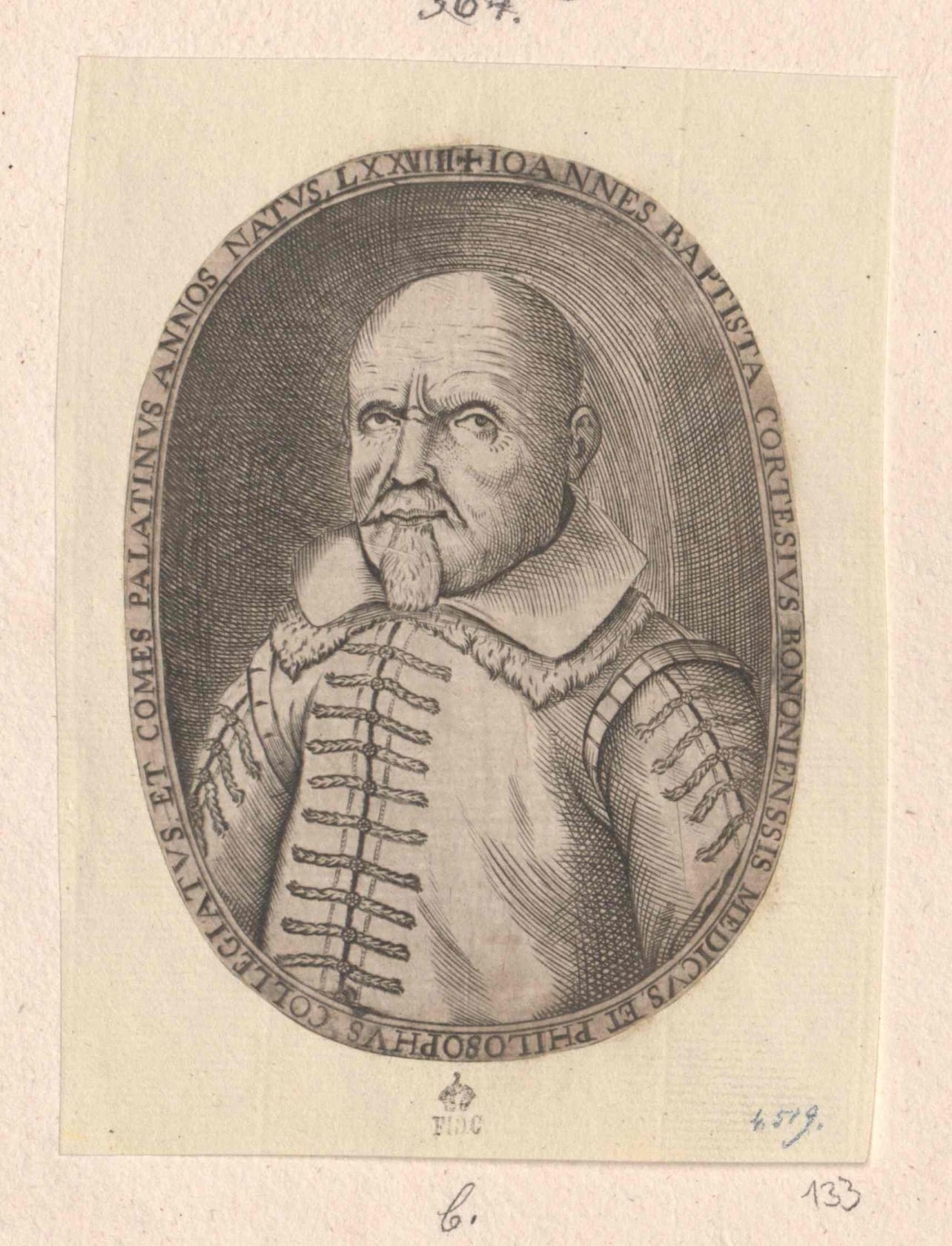
Giovanni Batista Cortesi. ÖNB, Austrian National Library.
We owe our gratitude to Dr. Paolo Savoia from the Department of History at King’s College London for his learned review of the life of Giovanni Batista Cortesi (1552-1643), a remarkable early Italian surgeon and physician who deserves to be better known. According to Dr. Savoia, the story of Giovanni Cortesi reads like a fairytale—how a poor tailor’s son rose from humble beginnings to become one of the most respected academicians of his time.
Dr. Savoia starts off by reminding us that surgeons in Cortesi’s time represented a spectrum of diversely trained persons, ranging from barbers, bone setters, and sellers of ointments, to practitioners hired by the city to treat people for free, hernia specialists, and university trained surgeons. Institutional arrangements varied in the different countries of Europe, but largely subsumed themselves to learned colleges of physicians and of surgeons, guilds of barber-surgeons, and academically trained practicing surgeons.
From the age of fifteen Cortesi had to earn a living, working in Bologna as a humble, lowly steam-bath attendant whose job was to wash and shave their clients, make them sweat, and apply cupping glasses. He later moved on to become a barber at the university hospital. But being possessed by an intense desire to educate himself, he was able to study grammar, Latin, and the natural sciences through the generosity of a donor who recognized his unusual intellectual ability. After winning in 1580 a competition to become an assistant at the hospital, he learned much by following the physicians on their daily rounds and observing the surgeons perform numerous operations. He then went on to study medicine, graduated in 1583, and two years later became lecturer in surgery at the University of Bologna. Devoting himself to the study of anatomy, he was appointed in 1590 first anatomical demonstrator for public dissection, and edited the posthumous book by Costanzo Varolio, who had been the professor of anatomy and medicine in Bologna. In 1590 he served as military surgeon for the Bolognese army in the war waged against bandits in Papal territories.
His reputation growing and his experience enhanced by his military service, he was invited in 1592 to France to care for an ailing cardinal. He stayed there for several months. On his return to Bologna he continued as lecturer at the university but found his chances for promotion impeded by local politics as well as by the low status of his family. He was a popular teacher, much admired for his public lectures, and he stood in high demand for his private demonstrations in anatomical dissections to small groups of students. But as he became tired of being an underdog and seeing no signs of progress, he accepted in 1598 the position of professor at the faculty of medicine of Messina in Sicily, then part of the kingdom of Naples. While finding the intellectual life not as rich as in Bologna, he was nevertheless able to widen his interest to natural history and even taught botany. He found that a shortage of cadavers limited his opportunities for making public dissections; but he moved with relative ease between anatomy, theoretical medicine, and practical surgery, and successfully taught and trained a new generation of competent Sicilian surgeons. He died in 1634 at the age of eighty during a sea voyage on a medical mission to Calabria.
Cortesi was the author of many treatises, mostly written between 1519 and 1635. In anatomy, he described or amplified early descriptions of the cerebellum, the optic nerve, and the carotid artery. In his medical words he wrote on plastic surgery of the lips, ears, and nose, especially on the reconstruction of the latter; on skull fractures and surgical dressings; and on the examination of the urine, purges, and bloodletting. He compiled a pharmacopeia of useful therapeutic drugs, some grown in local vegetable gardens. As a surgeon he exhibited considerable manual dexterity, and in 1633 he published a surgical manual, practical but also emphasizing the need for the learned surgeon to have studied the humanities, philosophy, and anatomy. He wrote that the surgeon must be young or close enough to a young age so as not to be hampered by weakness. He should always be ready to use both hands, have an acute and clear eyesight, and be possessed of a brave and merciless soul so as to be able to cut or cauterize without being affected by the screams of the patient.
Cortesi lived in an age when the study of anatomy was reaching its apogee and he made seminal contributions to medical and surgical care. Rising from the lowest level of a rigidly stratified society, he had to struggle to become educated and gain clinical expertise. During his later professional life, as Dr. Savoia reminds us, Cortesi had to skillfully navigate through an array of complex institutions, as well as compete in a landscape populated by skilled surgeons, learned theoretical physicians, and the great anatomists of the universities of northern Italy. Adjusting to his life in Sicily—which he described as a land of few people of letters, but still having some who delight in beautiful things—he always hankered to return to his native Bologna, but this never came to pass. Yet his life does indeed read like a fairytale, his rise from poverty and ascent to greatness serving as an inspiration for generations to come.
Further reading
- Paolo Savoia. Skills, knowledge, and status: The career of an early modern Italian surgeon. Bull Hist Med 2019; 93:1 (Spring)

Leave a Reply